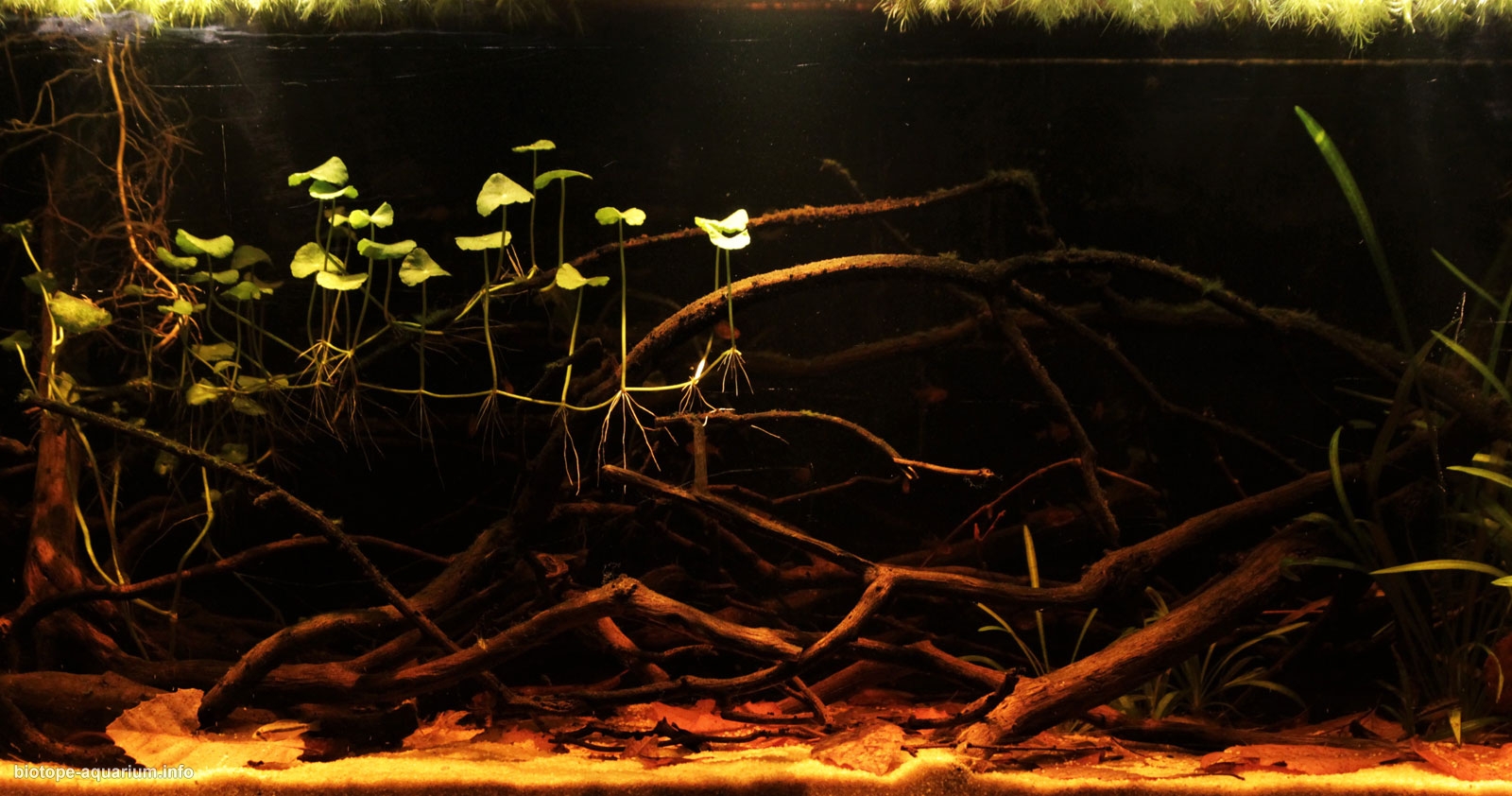Rio Nanay, National Reserve Allapahuayo-Mishana (Iquitos), Peru
30th place in Biotope Aquarium Design Contest 2017
![]() Italy. Lorenzo Strolighi
Italy. Lorenzo Strolighi

Volume: 96 L
Dimensions: 80x30x40 cm
List of fishes: Apistogramma allpahuayo, Hyphessobrycon amandae
List of plants: Echinodorus quadricostatus, Hydrocotyle leucocephala, Pistia (cosmopolitan).
Description of decorations: Substrate: fine sand, Decorations: driftwood and leaves.
Description of equipment: 2x9w Led PL lamp 6500°K, External filter Eden 511.
Water parameters: PH 5.2/5.5 – Conductivity: 40/50 microSiemens/cm T: 26-30 °C.
Description of the area surrounding the biotope: The Reserva Nacional Allpahuayo-Mishana it’s a large national reserve located within the rainforest south of Iquitos in the Loreto region of northern Peru. This rainforest reserve, sited between kilometres 23 and 31.5 west of the road from Iquitos to Nauta, covers an area of approximately 58000 ha..
Description of the underwater landscape of the biotope: The species inhabits most, but not all of the small black water stream of this area. On the basis of current knowledge the species appears to be endemic to the Rio Nanay system. All collection sites except one were situated within more or less dense forest. The brooks in which Apistogramma allpahuayo sp. n. was caught mostly contained black water, while some were slightly influenced by white water. I have tried to recreate a shallow black water biotope using sand at bottom and a lot of branches fallen down from the rainforest surrounding the river. A lot of dead leaves complete the habitat of this fish. Water is very soft < 50 microsiemens/cm and leaves, driftwoods and other botanicals items are used to obtain a dark, acid and full of tannin water. My Apistogramma couple spawned several times in my tank and now they live togheter in a small colony. It’s marvellous to see interaction between dominant males/female and other. I never separate fry from parents and never feed fry separately with naupli of artemia or somthing like this. They grow by themselves eating microfauna from the aquarium..
Description of the parameters of the habitat: This biotope is dedicated to the Peruan “Apistogramma allpahuayo” also known by different names as Apistogramma sp. “Black-chin/Schwarzkinn” or Apistogramma sp. “Fanta” or Apistogramma sp. “Pucallpa”. In 2012 has been officially described as Apistogramma allpahuayo. Apistogramma allpahuayo is apparently restricted to minor, mostly black water, tributaries and small rivers within the Reserva Nacional Allpahuayo-Mishanathe and west of the road between Iquitos and Nauta and therefore appears endemic to the Río Nanay watershed. This fish was collected several times so I well know water parameters to keep in my aquarium: PH 5.2/5.5 – Conductivity: 40/50 microSiemens/cm T: 26-30 °C.
List of fishes: The following fish species were collected together with Apistogramma allpahuayo sp.: several specimens of Aequidens sp., Cichlasoma sp., Crenicichla sp. (cf. saxatilis group), Laetacara flavilabris (Cope, 1870), Laetacara sp., Carnegiella cf. myersi FernandezYepez, 1950, Crenuchus spilurus Günther, 1863, Hoplias sp. (malabaricus?), Hyphessobrycon sp., Pyrrhulina sp., Thoracocharax cf. securis (Filippi, 1853), Hoplosternum spp. (2), Gymnotus spp. (3), and an Atinga species, probably Synbranchus marmoratus Bloch, 1795.
List of plants: Himatanthus, Eugenia, Ludwigia, Pontederia, Eichhornia, Limnobium, Hydrocotyle, Vigna, Utricularia, Azolla, Ceratopteris, Salvinia, Echinodorus, Pistia etc. etc.
Threats to the ecology: Owing to its ecology and endemic status within a comparatively small area, Apistogramma allpahuayo sp. n. may be considered potentially vulnerable, given the deforestation activities around Iquitos. It should therefore be placed on the lowest level (potentially vulnerable) of the red data list of the Peruvian fauna. Fortunately the most important and effective step in the conservation of this commercially attractive species has already been taken by declaring the Allpahuayo Mishana area a protected nature reserve on January 15th 2004, thus providing protection for a significant part of the species´ range. Within the limits of the Reserva Nacional Allpahuayo Mishana collection for scientific purposes is under clear restrictive regulation, and not permitted at all for commercial purposes.
Sources of information:
- http://apisto.sites.no/fish.
aspx?fishIndexID=2403& gruppeID=1 - http://www.senckenberg.de/files/content/forschung/publikationen/vertebratezoology/vz62-2/04_vertebrate_zoology_62-2_roemer_et_al_189-212.pdf pages 203-204
- http://www.minam.gob.pe/patrimonio-natural/wp-content/uploads/sites/6/2013/10/MAPA-NACIONAL-DE-COBERTURA-VEGETAL-FINAL.compressed.pdf pages 25-26-27
